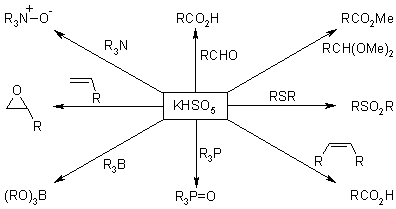Related compounds Molar mass 152.2 g/mol | Formula KHSO5 Appearance off-white powder | |
 | ||
Potassium peroxymonosulfate (also known as MPS, potassium monopersulfate, and the trade names Caroat and Oxone) is widely used as an oxidizing agent. It is the potassium salt of peroxymonosulfuric acid.
Contents
- 2016 2021 global potassium peroxymonosulfate industry trends survey and prospects report
- Reactions
- Uses
- References
This potassium salt is a component of a triple salt with the formula 2KHSO5·KHSO4·K2SO4. The standard electrode potential for this compound is +2.51 V with a half reaction generating the hydrogen sulfate (pH=0).
2016 2021 global potassium peroxymonosulfate industry trends survey and prospects report
Reactions
MPS is a versatile oxidant. It oxidizes aldehydes to carboxylic acids; in the presence of alcoholic solvents, the esters may be obtained. Internal alkenes may be cleaved to two carboxylic acids (see below), while terminal alkenes may be epoxidized. Thioethers give sulfones, tertiary amines give amine oxides, and phosphines give phosphine oxides.
Illustrative of the oxidation power of this salt is the conversion of an acridine derivative to the corresponding acridine-N-oxide.
MPS will also oxidize a thioether to a sulfone with 2 equivalents. With one equivalent the reaction converting sulfide to sulfoxide is much faster than that of sulfoxide to sulfone, so the reaction can conveniently be stopped at that stage if so desired.
MPS can also react with ketones to form dioxiranes, with the synthesis of dimethyldioxirane (DMDO) being representative. These are versatile oxidising agents and may be used for the epoxidation of olefins. In particular, if the starting ketone is chiral then the epoxide may be generated enantioselectively, this forms the basis of the Shi epoxidation.
Uses
Potassium peroxymonosulfate can be used in swimming pools to keep the water clear, thus allowing chlorine in pools to work to sanitize the water rather than clarify the water, resulting in less chlorine needed to keep pools clean. One of the drawbacks of using potassium peroxymonosulfate in pools is it can cause the common DPD #3 water test for combined chlorine to read incorrectly high.
